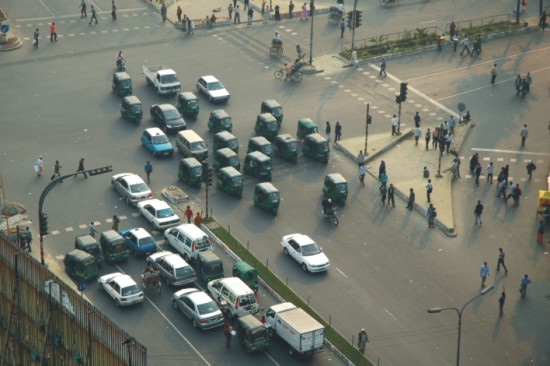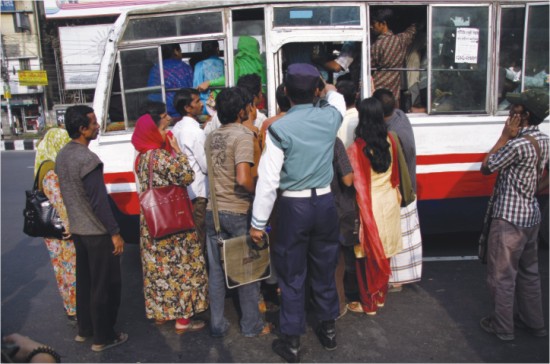
Inside
|
Traffic Jam Maruf Rahman explains the impact of a country's transport system on the people's quality of life The issues of transport, poverty, and the quality of our cities are all interlinked in various ways. To begin with, transport and poverty are, in brief, linked through individual and government spending on transport, and through transport and jobs.
Consider the issue of transport and individual expenditures. For low-income families, transport expenditures can represent a significant portion of monthly income. In Dhaka, the lowest income group spends 16.5 per cent of household income on transport, while the highest income group spends 8.2 per cent . Lack of access to appropriate transport can reduce the ability to access just those goods and services which would be needed to reduce poverty, that is, education, health care, and job opportunities. Low-income people are more likely to live far from work, and to have more than one job, which can greatly increase the time and money spent on transport. Meanwhile, for a low-income person, a one-time investment in a bicycle can spell tremendous savings for what would otherwise be spent on bus fares. One bicycle can serve an entire household, with parents using the bicycle to take their child to school, then using it to go to work and to the market. While two passengers can travel on one bicycle, they would have to pay separate bus fees; when making repeated trips during the day, again, a bicycle is far more affordable than other transport. Transport expenses can also be unaffordably high at the national level, though again, far more reasonable alternatives exist. Governments spend vast sums for building, widening, and maintaining roads, and on other infrastructure for cars, such as elevated expressways and multi-storey car parking. Governments also spend large amounts on fuel subsidies, and sometimes on inappropriate, high-cost public transit (such as an underground metro or sky train) where a better option is available (a street-level tram or bus rapid transit system). Governments must also bear the indirect costs of unwise transport decisions, including the costs caused by pollution, road crashes, and destruction of natural habitats to build roads. The issues of transport and jobs are of course closely inter-connected; as the philosopher Hannah Arendt observed, we all know that the reason we manufacture cars is not to move people, but to create jobs. Yet for the same investment made on fuel-dependent transport, far more jobs could be created through fuel-free transport. Jobs are indeed created due to fuel-dependent transport, such as building and selling cars, driving trucks, buses, cars, taxis, etc, or serving as an assistant on a bus or truck; pumping fuel, and fixing vehicles. Yet far more are created due to the use of fuel-free transport, such as building, selling, repairing, and pumping tires for bicycles and rickshaws; and serving as rickshaw pullers, van pullers, hand-cart vendors, etc. Higher costs and fewer jobs created from fuel-dependent transport should come as no surprise. After all, consider the issue of efficiency. Moving a 60-kilogram person using a 400-kilogram or more vehicle obviously generates considerable waste. That waste is compounded due to the space such vehicles require, and the fact that much of the time, the vehicles are either stored somewhere, or are sitting in traffic jams. That is, private cars involve moving few people for a lot of money, fuel, space and noise, while forcing the majority to suffer from lack of space for their far more efficient movements, obstructions like pedestrian bridges or underpasses, and exposure to danger, noise and fumes. The inefficiency also involves using most urban space for driving and parking, which leaves little space for outdoor activities. An efficient approach to transport issues would involve moving many people for little money, fuel, space and noise, giving most road space to the majority, creating pleasant walking conditions, and allocating a lot of space for outdoor activities, including via pedestrian streets, roads as playgrounds, and parks, not parking. Looking around the world, we see signs of two major trends: negative and positive. On the negative side of the equation, we may note that in Jakarta, 70 per cent of roads have no sidewalks. Imports of oil, gas, cars and trucks in 1989 consumed up to half of export earnings of Kenya and Thailand. And US cities use an average of 64.3 gigajoules of fuel energy/capita for transport, as compared to 25.7 GJ in European cities and 12.9 GJ in Asian cities. On the positive side, at least until recently, in most Chinese cities, 50-90 per cent of vehicular-passenger movements were by bicycle, and cycling remains common in small cities and the countryside of China. Until recently in India, there were about 25 times as many bicycles as motor vehicles. In medium-sized cities in Japan, Germany and the Netherlands, 40-60 per cent of all trips are made by walking or cycling, and governments in many cities, including Copenhagen, Paris, and London are working hard to increase the percentage of trips made by bicycle. Already in Copenhagen one of three trips to work are by bicycle, with the government trying to raise that figure to one in two buy 2015. Beyond the pollution and high costs of fuel use, other problems occur as well. Importing fuel drains scarce public resources that could be used for health care, and other basic programs. Exploration for and extraction and use of oil create massive environmental problems including the devastating consequences of climate change. The international fight to access (and control) oil supplies contributes to insecurity, notably but by no means limited to the war in Iraq. Further, the world's supply of oil is limited, so that ever-greater dependence on an ever-shrinking supply will lead to further insecurity and unimaginable problems in future. While it is often stated that the world has gained unprecedented wealth due to seemingly unlimited supplies of cheap energy, from another perspective, we have actually become improverished in perhaps unprecedented ways. The gap between rich and poor is greater than ever in history. Parallel to the disadvantages of fuel-dependent transport (FDT) are the advantages of fuel-free transport (FFT). FFT is affordable, flexible, often fast when compared to vehicles stuck in traffic jams, and provides door-to-door service. No foreign exchange is needed for its fuel, it creates no air or noise, utilises renewable energy rather than fossil fuel, relies on labor rather than capital, provides needed jobs for the poor, is an efficient way to make short trips, and uses little road space in addition to being easy to maneuver. The fact that FFT runs on food rather than fuel is a significant advantage, in that it motivates governments to grow and provide food for people, not vehicles. Meanwhile, given the growing worldwide epidemic of obesity and physical inactivity, a significant portion of the population needs to burn more food-as-fuel, while our countries would benefit if we burnt far fewer fossil fuels.
It is also important to remember that it is FDT, not FFT, that causes traffic jams. Consider the case of Los Angeles, where strict emissions regulations have failed to clean the environment, and where traffic congestion remains the greatest in all US cities; or Bangkok, where an estimated $1.4 million of fuel is wasted daily by vehicles idling in traffic, and where wasted productivity means that GNP could have grown by another 10 per cent if the weren't for all those traffic jams. Yet in neither city are there rickshaws, or even bicycles to speak of; only an overabundance of fuel-dependent vehicles, crawling traffic, and terrible air pollution. The World Bank is of course in the business of promoting businesses, not reducing poverty, yet even from the Bank, the usefulness of non-motorised transport can be found: "Transport interventions that promote the use of NMT usually contribute directly to the welfare of those people who cannot afford motorised transport. NMT is, many times, also the most appropriate and efficient from of transport." In addition to the direct connection to poverty reduction, transport issues are also key to a livable city, with the three being entwined (assuming that one prefers to live in a city where one needn't confront the daily reality of grinding poverty, and where people of different classes can mix without resentment or fear being the primary emotions). Clearly, environments are unpleasant when characterised by traffic jams, noise pollution, the inability to get around easily (particularly for children and the elderly), with no place to relax or play in the streets or even outdoors, and no environment for walking or lingering on the sidewalk. At the threat of over-simplification, one could say that bad environments consist of those that prioritise car traffic over the movement of people, such as -- but unfortunately by no means limited to – Bangkok, Los Angeles, and Dhaka. In such places, there is no escape from traffic and noise, and people do not linger outside their homes, and thus often do not know their neighbours. "Good" or livable cities, in contrast, promote happiness, health, and a good environment. In such cities, there are plenty of chances for people to meet others outdoors, places to walk free from traffic, places for children to play outdoors near their home and for adults to watch children. Good cities contain many good environments, including pedestrian streets, streets that set aside room for play, and make cars "visitors" (as in the Dutch "woonerf" concept). In such cities, there are plenty of outdoor areas to watch and interact with people, and there is little crime due to the presence of many people on the streets. This bring us to the radical concept that people have the right to be happy. But despite what the advertisers would like to convince us, happiness can't be bought with objects. Happiness comes from mixing with people (friends, acquaintances, and strangers); to do so, we need livable cities, in which it is possible to move about easily, and meet others outdoors. Such cities are truly wealthy cities -- in the concrete sense in that people will spend less on transport, and have more access to transport-related jobs, and in the more abstract sense of a city that people can love, and that shows its value daily to its citizens. In order to address these intertwined issues of transport, poverty, and livable cities, several steps are needed, including -- perhaps the most difficult -- a complete reorientation of our priorities and sense of "modern" city life. Such a change in paradigm will be followed by practical changes, such as a reduction in private car ownership and use.
This could be brought about by a number of ways, and preferably a combination of disincentives to use cars (higher tax to purchase cars, higher charges for parking, reduced access on the streets for cars) and incentives to move about in other ways (by encouraging and improving the conditions for walking, cycling, rickshaws, and public transit). Of course the two are related; as there are fewer cars, it will naturally be pleasanter and safer to move about by other means, and public transit will function more efficiently. The reverse is unfortunately also true, with the explosion in car growth leading, inevitably, to an explosion in car growth-unless strong measures are taken to reverse the destructive pattern. It is absolutely vital that we take into account poverty reduction, national economy, environment, and promotion of a "good" city when making transport policy, and that we plan a richer future for ourselves and our children -- not rich in the sense of more expensive metal boxes cluttering our streets and public places, but rich in the sense of a healthy and happy population. Maruf Rahman is a development worker.
|


